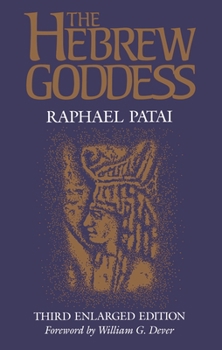Hebrew Goddess
(Part of the Raphael Patai Series in Jewish Folklore and Anthropology Series)
Select Format
Select Condition 
Book Overview
A revised edition containing new chapters on the Shekhina. The Hebrew Goddess demonstrates that the Jewish religion, far from being pure monotheism, contained from earliest times strong polytheistic elements, chief of which was the cult of the mother goddess. Lucidly written and richly illustrated, this third edition contains new chapters of the Shekhina.
Format:Paperback
Language:English
ISBN:0814322719
ISBN13:9780814322710
Release Date:September 1990
Publisher:Wayne State University Press
Length:408 Pages
Weight:1.05 lbs.
Dimensions:0.8" x 6.1" x 9.1"
Customer Reviews
5 ratings
Honoring the religion of Jewish mothers
Published by Thriftbooks.com User , 16 years ago
Patai presents a vast lore of the Hebrew goddess in all her names and legends - Shekhina, Sophia, the Matronit, the Shabhat Bride. As a classical scholar in Hebrew legends, he shows us a mythology rich in female powers. What does it mean, for example, that a traditional term for the Hebrew goddess was "the neglected cornerstone", and then Jesus spoke of building on the cornerstone which the builders neglected? The book touches on numerous sides of Jewish heritage. For example, concerning the underworld of old fashioned demonology he explains: "At night, the female Liliths join men, and the male Lilin women, to generate demonic offspring. Once they succeed in attaching themselves to a human, they acquire rights of cohabitation, and therefore must be given a get, or letter of divorce, in order that they may be expelled. Jealous of the human mates of their bedfellows, they hate the children born of ordinary wedlock, attack them, plague them, suck their blood, and strangle them. The Liliths also manage to prevent the birth of children, causing barrenness, miscarriages, or complications during childbirth." (p. 225.) This old myth suggests a certain equality of male and female evil spirits. The spirits are of both sexes, and afflict both men and women equally. The human hosts of evil are innocent victims, who must be somehow saved from harm. This is roughly what Jesus believed about demonic possession. Patai's work gives an enriched view of the biblical heritage, exposing the massive contribution of Jewish mothers through the ages.
The Feminine Aspect of G-d
Published by Thriftbooks.com User , 17 years ago
As a Jew and a student of Judaism this sits among the most important books I have read, although it took ten years for me to finish it. In a few words, it provides me with a factual-critical-intellectual basis for my engagement with the feminine in my tradition. I am only sorry the Dr Patai has passed on, may his memory be a blessing, so he will not be able to update The Herbrew Goddess to account for: a) more recent archaeology, and b) the recent flowering of the femininine in Judaism David
A excellent popular treatement of the subject
Published by Thriftbooks.com User , 18 years ago
Patai's The Hebrew Goddess is an excellent popular treatement of a subject he takes up in more technical depth in other writings (like in his Jewish Folklore, a collection of his essays). This book is enlightening; it takes an area of study that is easily overlooked or distorted in the popular imagination and the religious mind-frame, and exposes it to light. The role of the divine female and divine figures in the Abrahamic religions was a frequent stumbling block for those faiths, but more often than not, an area of expansive cross-fertilization with other religious traditions and source of profound (and at times humorous) creativity.
In the Begining, There was the Goddess
Published by Thriftbooks.com User , 21 years ago
This book is a very in depth, intelligent read. It draws from an intense amount of research and states things clearly for the reader to feel that they can envision the social, political and spiritual enviroment during the reign of the Goddess. I would recommend this book to anyone. In fact I think Everyone should read it. Ishtar, Innana, Shehkina, Astarte, Before Christian or Muslim, There was was the Goddess.
Was the Hebrew God a Woman?
Published by Thriftbooks.com User , 25 years ago
The Bible gives the impression that all ancient Jews shared a common belief system ... with only an occasional group straying from the fold. But the evidence paints a different picture. As Dr. Patai states, "... it would be strange if the Hebrew-Jewish religion, which flourished for centuries in a region of intensive goddess cults, had remained immune to them." Archaeologists have uncovered Hebrew settlements where the goddesses Asherah and Astarte-Anath were routinely worshipped. And in fact, we find that for about 3,000 years, the Hebrews worshipped female deities which were later eradicated only by extreme pressure of the male-dominated priesthood.And then there's the matter of the Cherubim that sat atop the Ark of the Covenant in the Holy of Holies. Fashioned by Phoenician craftsmen for Solomon and Ahab, an ivory tablet shows two winged females facing each other. And one tablet shows male and female members of the Cherubim embracing in an explicitly sexual position that embarrassed later Jewish historians ... and even the pagans were shocked when they saw it for the first time.This cult of the feminine goddess, though often repressed, remained a part of the faith of the Jewish people. Goddesses answered the need for mother, lover, queen, intercessor ... and even today, lingers cryptically in the traditional Hebrew Sabbath invocation.




